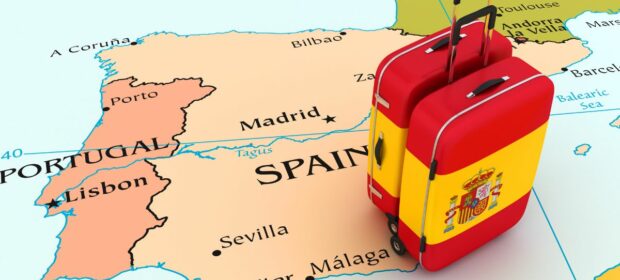It is all about the planning, solutions, implementation and continuing support (PSIC).
Why do your fellow affluent expats become clients of The Spectrum IFA Group in Spain?
By Barry Davys
This article is published on: 30th June 2025

We take as long as is necessary to understand your situation and listen to your hopes and plans for the future. It is time well spent because to be effective for you, we work to understand first, which then guides the process for your planning. In fact it governs how you and your adviser approach each step in our PSIC process..
So, why do wealthy expatriates become clients of The Spectrum IFA Group in Spain?
- Secure document exchange and secure email
- We take into account your views, especially in your approach to risk
- We look forward, not just backwards at past performance
- Cashflow modelling allows you to see what your financial future could look like and includes a “What if” function to allow you to see potential outcomes before you commit to a decision
- Investment portfolios are built according to your individual objectives, using a discretionary fund manager if appropriate. Historic performance data from 1990 to 2023 is used for reliable and realistic cashflow forecasting
- When you become a client of The Spectrum IFA Group in Spain, we take into account the impact of the following in our planning and investment recommendations: Wealth tax, Income tax, Capital gains tax, Inheritance tax, Gift tax, Property tax and how to mitigate the impact of these taxes
- We plan across generations
- We understand both UK and Spanish taxes, how they work together and where they conflict, to help with cross-border tax planning
- Our assistance has included planning leading up to and post business sales, structuring share option vesting, managing property sale proceeds, investment of lottery/premium bond wins and gifts and advice for adult children of clients.
- Ongoing service which follows a clear process to ensure long-term planning remains fully aligned with your circumstances
- The Spectrum IFA Group has been advising in Spain for 23 years. We currently have 17 advisers across the group who have been with us continuously for 20 years or more
- Additional tax guidance and reporting – in Catalonia I work with only two firms of tax lawyers after vetting dozens.
- I call on the support of a specialist Visa lawyer to advise on and apply for visas
- We have a specialist mortgage service within the group – Spectrum International Mortgages is a mortgage broker in Spain with extensive experience handling high value transactions. A search of one estate agent’s offering in the area around S’Agaro, Costa Brava, shows the following available properties:
– 31 over €1M
– 13 over €2M
– 7 over €3M
– 3 over €4M
– 1 over €5M
– 1 over €6M
– 2 over €7M
– 1 over €8M
– 6 with Price by Request

- Our mortgage solutions are available as a stand alone service or as part of our PSIC process – the PSIC process itself is best suited to clients with €500,000 or more to invest
If this is how you want your planning to be managed, book an initial call directly with Barry Davys, at a time that is convenient for you, using his online service. You will be offered the choice of a phone call or a video call when choosing your time.
Relocating to Spain
By Barry Davys
This article is published on: 27th June 2025

Are you planning to relocate to Spain and don’t know where to start? Are you a Spanish national thinking of coming back to Spain after more than 5 years in the UK?
Barry Davys was a guest with the Spanish Chamber of Commerce alongside Kle&Vera – the international law firm, in the UK for a recent webinar on Relocating to Spain & the Financial Insights.
You can watch part of this webinar below:
If you have any questions after watching the video or would like to talk to Barry, please use the online calendar booking system to choose a time that suits you.
Behavioural Confirmation: The Sneaky Culprit Behind Your Wallet’s Woes
By Tom Worthington
This article is published on: 27th May 2025

Ever feel like your wallet has a mind of its own? You set out to save, but somehow end up splurging on that fancy coffee machine or the latest gadget. Let’s delve into the psychological phenomenon known as behavioural confirmation and see how it might be influencing your financial decisions.
What Is Behavioural Confirmation?
Behavioural confirmation is a type of self-fulfilling prophecy where our expectations about others lead them to behave in ways that confirm those expectations. In the realm of personal finance, this can manifest when we project our beliefs onto our spending habits, leading to outcomes that align with those beliefs—even if they’re detrimental.
Spending Habits: The Self-Fulfilling Cycle
Imagine believing you’re terrible at budgeting. This belief might cause you to avoid tracking expenses, leading to overspending, which then reinforces your initial belief. It’s a vicious cycle where your expectations shape your behavior, confirming your original assumption.
Similarly, if you think you’re a savvy investor, you might take on riskier investments without proper research, leading to potential losses that challenge your self-perception.
Investments: Confidence vs. Overconfidence
Believing in your investment prowess is great, but overconfidence can be costly. You might ignore warning signs or dismiss advice, thinking you know best. This can lead to poor investment choices, reinforcing the belief that the market is unpredictable, rather than acknowledging personal missteps.
Imagine believing you’re the next Warren Buffett after a couple of successful trades. This mindset, while empowering, can sometimes lead investors astray. Overconfidence bias is a well-documented phenomenon in Behavioural finance, where individuals overestimate their knowledge, underestimate risks, and exaggerate their ability to create returns.
Initial Success: An investor experiences early gains, attributing success solely to personal skill.
- Increased Risk-Taking: Buoyed by confidence, the investor undertakes riskier investments without thorough analysis.
- Neglecting Diversification: Believing in their ability to pick winners, the investor concentrates holdings, ignoring the benefits of a diversified portfolio.
- Ignoring Contradictory Information: The investor dismisses data or advice that challenges their beliefs, leading to potential blind spots.
- Potential Losses: Without proper risk assessment and diversification, the investor becomes vulnerable to market downturns, leading to significant losses.
Real-World Implications
- Excessive Trading: Overconfident investors often trade more frequently, incurring higher transaction costs and taxes, which can erode returns.
- Underestimating Risks: Believing they can predict market movements, these investors may overlook potential pitfalls, leading to investments in volatile or unsuitable assets.
- Confirmation Bias: Overconfident individuals tend to seek information that supports their views, ignoring evidence to the contrary, which can reinforce poor investment choices.
Mitigating Overconfidence
- Seek Diverse Perspectives: Engage with financial advisors or peers to gain different viewpoints and challenge personal assumptions.
- Implement Checklists: Before making investment decisions, use a checklist to ensure all factors, including risks and alternatives, are considered.
- Embrace Humility: Recognize the limits of personal knowledge and remain open to learning and adapting strategies.

Breaking the Cycle
To combat Behavioural confirmation:
- Self-awareness: Regularly assess your financial beliefs and challenge negative assumptions. Don’t start saving tomorrow, start saving today.
- Seek feedback: Discuss financial decisions with trusted individuals to gain different perspectives. This is exactly what a financial adviser can help you with.
- Stay open to options presented to you.
- Set realistic goals: Establish achievable financial objectives to build positive reinforcement loops.
Think of your financial beliefs as that friend who insists they’re bad at directions. Every time they get lost, they say, “See? I told you!” But maybe, just maybe, if they used a map or GPS, they’d find their way. Similarly, by challenging our financial self-perceptions and seeking guidance, we can navigate towards better financial health.
At the Spectrum IFA Group we can help you by being your GPS through the financial world and design your bespoke road map to make sure we you get to where you want to go.
Top financial tips Spain May 2025
By Chris Burke
This article is published on: 8th May 2025

Happy (Almost) Summer, everyone!
So far this year, the weather has been very unusual, to say the least. Hopefully, things will start to feel a bit more normal soon – which brings me nicely to the financial world, which has been anything but normal! Sometimes it feels like many of us are just pawns in the game that very powerful people play.
In my world, however, many of these ‘games’ are understandable from a financial perspective, and we don’t panic. Instead, we factor in all scenarios and focus on the medium- to long-term goals for our clients.
This month, I’ve put myself in my readers’ shoes and asked:
“What financial planning should I be doing while living in Spain?”
Whether you’re new to Spain (generally considered to be less than three years) or well-established, it’s important to stay financially organised and understand what actions you need to take.
Living abroad as an expatriate requires thoughtful financial planning to navigate both Spanish and international financial systems. Here are the key areas to consider:
1. Understand Tax Residency and Obligations
In Spain, spending over 183 days within a calendar year establishes you as a tax resident, meaning your worldwide income and assets may be subject to Spanish taxation. It’s crucial to understand the rules around tax residency to avoid unexpected liabilities.
2. Strategise Property Sales and Investments
If you own property in your home country, consider carefully when to sell. Selling property in the same tax year you become a Spanish resident can lead to significant capital gains taxes. Planning the sale before relocating may help mitigate this issue.
3. Establish a Comprehensive Estate Plan
Creating a Will that covers both your home country and Spain is essential to ensure your assets are distributed according to your wishes. It’s wise to consult with advisers experienced in cross-border estate planning to navigate the complexities.
4. Optimise Currency Management
Managing currency exchange efficiently can help minimise losses due to fluctuating exchange rates. Consider using multi-currency accounts or international banking services to provide greater flexibility and cost savings.
5. Savings, Investments & Pension Planning
Ensure these are structured to reduce future tax liabilities—whether that’s for withdrawals, passing assets to your spouse or children, or aligning with your investment expectations (e.g., risk/reward balance). Most importantly, work with someone you trust to help manage these assets.
6. Consult with Experts
Whatever your budget, make sure you work with a recommended lawyer, tax adviser, accountant, and financial adviser. In Spain, you are considered guilty until proven innocent, and it can take years to resolve legal issues—during which your bank accounts or assets may be frozen. Many expats are unaware of this, especially if they come from countries where the opposite presumption applies.
7. Use Your Life Experience
When choosing the right advisers, trust your gut—or your “spider senses,” as I like to call them. You’ve built up intuition through life experience, and more often than not, it’s spot on.
Engaging with financial advisers who specialise in expatriate services can provide tailored guidance on investment strategy, tax planning, and navigating financial matters in both Spain and your home country.
By proactively addressing these areas, you can establish a solid financial foundation for your life in Spain – ensuring both compliance with local regulations and alignment with your long-term goals.
I’m here to help you get organised and take those financial worries away. If you’d like to discuss any of the topics above in more detail, or would like an initial consultation to explore your personal situation, you can do so here.
Click here to read independent reviews on Chris and his advice.
Navigating Market Volatility
By Tom Worthington
This article is published on: 5th May 2025

How It’s Impacting Investors and What’s Driving It
In today’s economic rollercoaster, market volatility has become a feature, not a bug. Thanks to inflation, interest rates, and politicians who change their stance more often than they change their ties, investors are left riding waves of uncertainty
What Is Market Volatility?
Market volatility refers to how wildly asset prices swing around. It’s measured with stats like standard deviation or the VIX—aka the “fear index.” When VIX is high, it means traders are about as calm as a cat in a bathtub.
Think of volatility like a political debate: a lot of shouting, some overreactions, and nobody quite sure what the outcome will be—but everyone’s got an opinion.
How Volatility Is Affecting Buyers
- Increased Risk Aversion
When markets get shaky, investors run for the hills—or more precisely, into gold, bonds, or the financial equivalent of curling up under a blanket and binge-watching Netflix: cash. It’s not that they don’t want to invest; it’s just hard to focus on stocks when the economy’s behaving like a budget committee after three espressos.
- Short-Term Focus and Emotional Decisions
High volatility often leads to panic selling and FOMO buying—essentially the investment version of speed-dating your portfolio. One bad news headline and people dump their assets faster than a politician deletes tweets after a scandal.
- Greater Demand for Diversification and Alternatives
With public markets swinging like a metronome at a concert, investors are looking elsewhere: real estate, private equity, and alternatives that don’t fluctuate every time a central banker clears their throat.
Alternative strategies are basically the Switzerland of investing—neutral, quiet, and generally unaffected by the chaos going on next door.
- Hesitation in Major Life Investments
When markets are turbulent, people freeze. Buying a house. Starting a business. Investing in that avocado farm you saw on Instagram?! Better wait until the economy isn’t throwing daily tantrums like it’s on a sugar high.

What’s Causing the Current Volatility?
Geopolitical Tensions
Let’s face it—if the markets had a relationship status, it would be “It’s complicated.” Global tensions (Ukraine, Middle East, China-US trade) have created an environment where investors are just one diplomatic gaffe away from selling everything and moving to the woods.
And with international summits resembling more of a group therapy session than a solutions meeting, it’s no wonder markets are twitchy.
Inflation and Central Bank Policy
Central banks are trying to tame inflation with interest rate hikes—kind of like trying to put out a grease fire by hitting it with a calculator. Every time Jerome Powell or Christine Lagarde so much as raise an eyebrow, markets react like they just heard tax hikes are back on the menu.
Recession Fears
Recessions, Soft landings, Hard landings… No landing? At this point, the economy is basically being piloted by someone reading the instruction manual upside down. With mixed signals and conflicting forecasts, markets are responding like passengers on a turbulent flight—fastening their seatbelts and ordering strong drinks.
Tech and Social Media Hype
Social media has turned investing into part-time entertainment. Between Reddit-fueled pump-and-dumps and influencers recommending crypto in between smoothie recipes, market swings have become more meme than metric. Add algorithmic trading and you’ve got a digital casino with fewer rules and more drama than the House of Commons.
Earnings Uncertainty
Earnings season now feels like a bad date—lots of build-up, dramatic reveals, and someone always ends up disappointed. With rising costs and unpredictable demand, analysts are doing more guesswork than polling firms during a leadership race.

How Investors Can Respond
Here’s what smart investors are doing—besides stress-eating during market dips:
- Keep a long-term perspective: Ignore the noise—just like a seasoned voter during campaign season.
- Diversify: Don’t put all your eggs in one economic basket—especially if that basket is being carried by a toddler on roller skates.
- Use euro-cost averaging: Invest steadily over time, so you’re not stuck trying to time the market like a trying to explain your latest impulse buy to your other half.
- Hedge your bets: Consider options and other protections—because unlike political promises, these can actually reduce risk.
- Stay informed, not alarmed: Headlines sell panic; good decisions are made with data, not doomscrolling.
Conclusion
Volatility might be nerve-wracking, but it’s not the enemy. It’s a changing a nappy—messy, emotional, and always changing—but ultimately navigable if you stay calm, stay smart, and remember that every cycle, no matter how wild, eventually turns.
So hold onto your investments, keep a sense of humour, and remember: if in doubt talk to your adviser.
Are You Leaving 40% of Your Assets to the Taxman?
By Jett Parker-Holland
This article is published on: 22nd April 2025

Most people try to do the right thing. They work hard, save diligently, contribute to their pensions, and even invest in property to secure a comfortable retirement and leave something behind for their loved ones. It’s the responsible thing to do, but recent changes to the UK tax system have turned that logic on its head, especially for British expats living abroad or planning to retire in Spain.
As of April 2025, a new inheritance tax test will be introduced, replacing the ambiguous concept of domicile with a more definitive measure: residency. If you are living—or planning to live—in Spain for the long term, this change affects you directly. Under the new rules, if you have lived outside the UK for at least 10 of the last 20 years, you’ll be classified as a non-UK Long-Term Resident. This is important because it means your overseas assets will no longer be subject to UK Inheritance Tax (IHT); however, UK-based assets such as pensions, property, and bank accounts will still be taxed at 40%.
For many clients, much of their estate remains tied up in the UK. This includes UK property, bank accounts, and—most notably—UK pensions. Although yields on UK assets like rental property or fixed-term bank deposits can appear attractive, the long-term benefit may be diminished if 40% of the value is lost to IHT on death. Because of this, those planning to live in Spain for the long term may want to consider moving certain assets out of the UK tax system. It’s an area where careful financial planning can make a real difference.
The same applies to pensions. Under the old regime, UK pensions were exempt from IHT. Now, pensions are included as part of your estate. If you pass away after age 75, your beneficiaries could face a 40% IHT charge, and potentially up to another 45% in income tax when they take money out of the pension. It’s a harsh reality and fundamentally changes how we should value UK pensions. If your beneficiaries can’t access the full pot, it’s simply not as valuable as it once was. Under these conditions, a £400,000 pension could lose £160,000 to IHT alone.
At Spectrum, we specialise in cross-border financial planning. We can help you review your UK assets and explore options to reduce your exposure to unnecessary taxes, ensuring more of your hard-earned wealth stays with your family, not the taxman.
If you’re living in Spain, or planning to, and you’re unsure how these changes affect you, this may be a good time to review your plans. A short conversation could help secure your legacy.
If you would like to discuss your situation in more detail and explore your options, please feel free to contact me directly for a no-obligation consultation.
Navigating Offshore Banking: What Superyacht Crew Need to Know
By Tom Worthington
This article is published on: 18th April 2025

For those working aboard superyachts, managing finances across multiple countries is part of the job. Offshore banking is a common topic in the industry, but what does it actually mean? More importantly, how can superyacht crew members ensure they use offshore accounts legally and effectively?
What is an Offshore Account?
An offshore account is a bank account held outside the account holder’s country of residence. These accounts are often established in jurisdictions known for financial privacy, currency flexibility, and, in some cases, tax efficiency. Common offshore banking hubs include Switzerland, the Cayman Islands, Singapore, and Luxembourg.
Key Features of Offshore Accounts
• Multi-Currency Access – Useful for those paid in different currencies or working in international waters.
• Privacy & Confidentiality – Some jurisdictions have strict banking secrecy laws.
• Tax Efficiency – Depending on residency status, offshore accounts may offer tax advantages.
• Asset Protection – Offshore banking can safeguard funds from political instability or legal claims.
Are Offshore Accounts Legal?
Yes. Offshore banking is entirely legal, provided account holders comply with tax reporting obligations in their country of residence. Many governments enforce strict regulations requiring individuals to disclose offshore accounts.
Key compliance measures include:
• Common Reporting Standard (CRS) – Over 120 countries automatically share offshore account data with tax authorities.
• Foreign Account Tax Compliance Act (FATCA) – A U.S. law requiring Americans to report foreign financial accounts.
Failure to disclose offshore accounts can result in heavy fines, tax penalties, or even legal action. However, when used correctly, offshore accounts serve legitimate purposes such as international transactions, estate planning, and investment diversification.
How Offshore Banking is Enforced
The days of absolute banking secrecy are over. Since the introduction of CRS in 2018, tax authorities worldwide have cracked down on undisclosed offshore assets. Here are a few key examples:
Switzerland’s Secrecy Crumbles
• Over 3.1 million accounts worth €1.3 trillion were reported in the first year of CRS.
• Countries like France, Germany, and Italy used this data to launch tax audits on individuals with undeclared Swiss accounts.
• Many account holders voluntarily disclosed assets to avoid penalties.
Spain’s Offshore Crackdown
• Over 11,000 undisclosed offshore accounts were uncovered from 2020-2023.
• Tax authorities recovered millions in unpaid taxes and issued heavy fines.
• High-profile cases, including football stars like Cristiano Ronaldo and Lionel Messi, highlighted the risks of offshore tax evasion.
UK’s HMRC Recovers £570 Million
• The UK’s tax authority identified over 150,000 residents with hidden offshore accounts.
• £570 million was recovered in unpaid taxes.
• Stricter penalties were introduced for failure to declare offshore wealth.

What This Means for Superyacht Crew
Superyacht crew frequently work across jurisdictions, earning salaries in different currencies and often living outside their home country.
This can make offshore banking an attractive option, but it’s crucial to remain compliant with tax laws.
Key Considerations:
• Know Your Tax Residency – Your tax obligations depend on where you are officially resident, not just where you work.
• Report Your Offshore Accounts – Avoid penalties by declaring foreign accounts where required.
• Seek Professional Advice – Offshore banking and tax laws are complex. Consulting a financial adviser who understands the yachting industry can help navigate the rules effectively.
Final Thoughts
Offshore banking is a useful financial tool when used correctly. However, with increasing transparency and global information-sharing agreements like CRS, hiding offshore assets is no longer an option.
Superyacht crew should approach offshore banking with full awareness of their legal responsibilities to ensure financial security without unnecessary risks.
To make sure you are doing it properly, feel free to contact Tom
New UK IHT rules
By John Hayward
This article is published on: 7th April 2025

As of 6th April 2025, several significant changes to inheritance tax (IHT) laws have been implemented in the United Kingdom. For the purposes of this article, I will focus on those people that I deal with in the main, namely UK nationals who are tax resident in Spain.
From a UK perspective, under the new rules, an individual will be classified as a “Long-Term Resident” (LTR) if they have been UK tax resident for at least 10 out of the previous 20 tax years. LTRs will be subject to IHT on their worldwide assets. Conversely, UK nationals who have lived in Spain for 10 out of the previous 20 years will only be liable for IHT on UK-situated assets.
For individuals planning to leave the UK, there will be a “tail” period during which their worldwide assets remain subject to UK IHT. The duration of this tail depends on the number of years the individual was UK resident, ranging from three to ten years.

Inheritance Tax threshold freeze
The IHT threshold, the nil-rate band, which determines the value above which estates are subject to tax, is frozen until 2030. In other words, the value of an estate may increase but the allowance will not. The threshold for the majority of those affected is £325,000. This means that estates valued above this threshold will be taxed at 40%. As there is an inter-spouse exemption in the UK, the surviving spouse will normally inherit the deceased’s allowance creating an allowance of £650,000. There is no such exemption in Spain but, depending on where someone lives in Spain, a beneficiary might be eligible for an allowance to be applied. These (Spanish) tax rules have changed regularly over the two decades that I have lived in Spain and so it is probably wise not to put too much reliance on them for long-term financial planning.

Inclusion of pensions in Inheritance Tax
Beginning in April 2027, pension funds will be considered part of the assets subject to IHT. This means that pension funds outside the UK could be exempt. At the same time, the UK has recently introduced a 25% charge for moving pension funds to overseas schemes (QROPS). Although this might appear to put the final nail in the coffin of the overseas pension transfer market, there could be a Lazarus moment. In simple terms, if a UK based pension fund is valued at £1,000,000 and is moved to QROPS, the fund would reduce to £750,000 after applying the 25% charge. For those who prefer skiing (spending the kids’ inheritance) the same fund left in the UK pension could be subject to a 40% IHT charge, obviously more than if the fund had been transferred with a 25% charge. Growth assumptions and other factors will need to be considered but overseas transfers cannot be ignored.

How UK and Spanish IHT apply to Spanish compliant bonds
As we can see, assets in the UK will be subject to UK IHT. Why not just move cash from the UK to Spain? The problem here is that this opens the Spanish tax door.
As well as bank deposits, there might be ISAs and other UK investment plans which will be subject to UK IHT. UK advice has been restricted since Brexit and, for most tax residents of Spain, holding certain assets in the UK is simply not tax efficient. But moving everything to Spain could also cause problems.

Investment options
We arrange investment bonds, often referred to as Spanish compliant bonds, which are recognised as insurance policies and benefit from the favourable tax treatment in Spain even though they are not situated in Spain. The bonds we recommend are based in Ireland and Luxembourg, both in the EU, satisfying Spain’s conditions. For Spanish IHT, Spain will tax the individual receiving the benefit if either a) the beneficiary is resident in Spain or b) the asset is in Spain. This means that a UK resident beneficiary will not pay Spanish IHT on the bond. Equally, if the deceased is a non-Long Term Resident of the UK under the new rules, the bond will not be part of a UK IHT calculation.
The main aim of a Spanish compliant bond is to increase the value of the underlying investment whilst putting clients in a position to supplement their income. Of course, any investment should reflect the tax regime of the country that the person is resident in. The bonds can move with the individual for these purposes. For example, whilst a resident of Spain, the Spanish tax deferral rules apply. If the person moves back to the UK, the UK rules then apply with the added benefit that tax relief available in respect of time spent outside the UK.
For more information on how we can help you position your money in the most tax efficient manner, contact me at john.hayward@spectrum-ifa.com or (0034) 618 204 731 (WhatsApp).
Major changes are ahead for British expatriates living abroad
By Jeremy Ferguson
This article is published on: 24th March 2025

Historically, the concept of “domicile” has been central to determining UK Inheritance Tax obligations for British citizens. Many British expats found that despite decades abroad, they were still deemed UK domiciled on their demise, exposing not just their UK assets but their global estates to UK Inheritance Tax.
New rules which soon come in to effect mark a major shift in this area, particularly impacting British expatriates who have been living overseas for extended periods, replacing the concept of domicile with new long-term residence (LTR) rules. Under these new rules, the test for liability to UK Inheritance taxes will be based on your residency.
For those of you who have lived outside of the UK for at least 10 of the last 20 years, you will now be classified as non-UK long-term residents. This change means your global assets (except UK based holdings such as pensions, property, investments and bank accounts) will be exempt from UK Inheritance tax.
Therefore, if you are intending to remain out of the UK indefinitely or you have already been out of the UK for more than ten years, you should seriously consider moving assets outside of the UK.
As an example, if you hold funds in a UK bank account in GBP then these will remain subject to the old IHT rules as they will be classed as a UK asset, so if the monetary amounts are substantial enough, it makes perfect sense to move these funds outside of the UK. This is something we can help you with by explaining what options are available and where the best interest rates can be found. (This could even offer you the chance of deferring annual taxes here on any interest earned).
On one hand they giveth, however on the other hand they taketh away
An expression many of you will be familiar with. For those of you who watch the UK news, many will be familiar with the plight of the UK farmers who are up in arms about the change in the tax treatment of their farms on inheritance. What amazes me is the fact that in the same budget, the Government announced that UK pensions are now going to form part of your assets assessed for Inheritance taxes, whereas previously they were exempt. I explained earlier about the favourable changes if you live outside of the UK, so on one hand they giveth, but now your pension will be subject to UK Inheritance tax, they taketh away!

This is a real sting in the tail if you have planned to leave your pension to your children due to the tax efficiency this previously offered. If we look at the worst case scenario under the new regime, you have a UK pension and pass away after the age of 75, your beneficiaries could now be hit with a 40% UK Inheritance tax charge and on top of that there could be further tax liabilities when they choose to take income (of up to another 45%…….). I am simply amazed that these facts aren’t getting the column inches the farmers are getting. Again, because of this there may be sense in moving as much of your pension out of the UK scheme as possible.
As with anything as important as this, planning and taking action could save you and your family a fortune in unnecessary taxes. We are here to help explain the issues, sensible ways to deal with them and ultimately helping you to make a well informed decision as to what you should or shouldn’t do..
News addiction can damage your wealth
By John Hayward
This article is published on: 3rd March 2025

Basing investment decisions on daily headlines has led to financial loss
We are a couple of months into 2025 and many aspects of life seem to be engulfed in uncertainty which is no great shock because that has always been the standard. Recent headlines have been pretty much the same as these from the 1960s.
- Washington, Moscow establish ‘hot line’ link
- New peace plan for Middle East
- Rail go-slow begins
- Canada plane crash
Not a lot really changes apart from the global population and prices. Yet it seems that very little is learned with all of this experience. People react to headlines and make decisions based on what might well be complete nonsense. The press obviously has to write stories but that does not mean that they are accurate, or even true.
“Watch what we do, not what we say.”
– John Mitchell, Attorney General to Richard Nixon, 1969

All of this has come to the fore with particular focus on Donald Trump and his team. Many people now have a negative outlook because Donald Trump was elected again. Clients have been asking me if their investments have been affected. They have been pleasantly surprised to learn that, far from the investment world imploding, the value of their investments is higher than it was when Donald Trump was elected on 5th November 2024.
Of course, markets can go down as well as up. However, history has shown us that, over time, there have been more ups than downs.
When considering savings and investments, it has often been wiser to ignore the daily headlines and allow things to sort themselves out which, more often than not, they do. We have already seen how the President can appear to regularly change his mind and moving with these political waves could lead to investment nausea.
When he was first President from 2017 to 2020, the S&P 500 index rose by 47% during his term. The message is that the United States of America is the place to have at least some money right now, if not always. The unfortunate fact of life is that stock markets appear to be more important than the well-being of people in general.
In June 2023, clients of mine decided to surrender their investment plan as they felt that they would do better in a deposit account. In 2023, with high inflation leading to high interest rates, 5% interest in a deposit account seemed extremely attractive to them. I am not certain if they are still receiving 5% but, even if they are, they are about 7% down on what they would have had if they hadn’t surrendered their policy and had left the funds intact. Added to that, they will have had to have paid tax each year on the interest whereas tax on the investment gains would have been deferred whilst within the Spanish compliant bond they had. So often, people react to the headlines, make decisions based on short-term market movements, and lose out. And then blame their financial advisers!

I discourage focusing too much on daily headlines. Other than a story about a cat rescued from a tree, headlines are rarely cheery and there is almost always nothing we can do about what has happened. By taking a lot of notice of daily news, one can be led to making decisions that will lead to regret.
For a considered approach to investing, making you aware of taxation in Spain and the UK, contact me today.
Coming to an email box near you:
- Premium Bonds and their value in Spain
- Consolidating UK private pensions
- Claiming state pensions
- Entry/exit system
- Power of attorney

